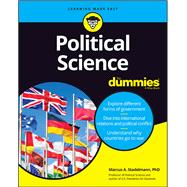Expand your political science knowledge with a book that explains concepts in a way anyone can understand!
The global political climate is dynamic, at times even volatile. To understand this evolving landscape, it’s important to learn more about how countries are governed. Political Science For Dummies explores the questions that political scientists examine, such as how our leaders make decisions, who shapes political policy, and why countries go to war. The book is the perfect course supplement for students taking college-level, introductory political science courses. Political Science For Dummies is a guide that makes political science concepts easier to grasp.
- Get a better understanding of political ideologies, institutions, policies, processes, and behavior
- Explore topics such as class, government, diplomacy, law, strategy, and war
- Learn the specialized vocabulary within the field of political science
- Help prepare for a range of careers, from policy analyst to legislative assistant
Political science crosses into many other areas of study, such as sociology, economics, history, anthropology, international relations, law, statistics, and public policy. Those who want to understand the implications of changing political economies or how governing bodies work can look to Political Science For Dummies. It’s the book thatcuts through the jargon as it focuses on issues that interest readers.








